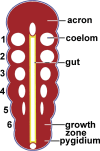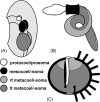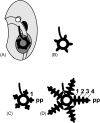The Metameric Echinoderm
- PMID: 38558855
- PMCID: PMC10980344
- DOI: 10.1093/iob/obae005
The Metameric Echinoderm
Abstract
Animal phyla are distinguished by their body plans, the ways in which their bodies are organized. A distinction is made, for example, among phyla with bodies of many segments (metameric; e.g., annelids, arthropods, and chordates), others with completely unsegmented bodies (americ; e.g., flatworms and mollusks), and a few phyla with bodies of 2 or 3 regions (oligomeric; e.g., echinoderms and hemichordates). The conventional view of echinoderms as oligomeric coelomates adequately considers early development, but it fails to recognize the metameric body plan that develops in the juvenile rudiment and progresses during indeterminate adult growth. As in the 3 phyla traditionally viewed to be metameric (annelids, arthropods, and chordates), metamery, or metamerism, in echinoderms occurs by (1) subterminal budding of (2) serially repeated components of (3) mesodermal origin. A major difference in most echinoderms is that metamery is expressed along multiple body axes, usually 5. The view of a metameric echinoderm might invite new discussions of metazoan body plans and new approaches to the study of morphogenesis, particularly in comparative treatments with annelids, arthropods, and chordates.
Tierstämme zeichnen sich durch ihren Körperbauplan, das heist, die Art und Weise aus, wie ihre Körper organisiert sind. Man unterscheidet beispielsweise Stämme mit Körpern aus vielen Segmenten (metamerer; z. B. Ringelwürmer, Arthropoden, Akkordaten), andere mit völlig unsegmentierten Körpern (amerer; z. B. Plattwürmer, Mollusken) und einige wenige Phyla mit Körpern aus zwei oder drei Regionen (oligomerer; z. B. Stachelhäuter, Hemichordaten). Die herkömmliche Sichtweise von Stachelhäutern als oligomere Coelomate berücksichtigt die frühe Entwicklung angemessen, berücksichtigt jedoch nicht den metameren Körperplan, der sich im jugendlichen Rudiment entwickelt und während des unbestimmten Erwachsenenwachstums fortschreitet. Wie bei den drei Phyla, die traditionell als metamer angesehen werden (Anneliden, Arthropoden, Chordaten), erfolgt Metamerie bei Stachelhäutern durch (1) subterminale Knospung von (2) seriell wiederholten Komponenten (3) mesodermalen Ursprungs. Ein wesentlicher Unterschied bei den meisten Stachelhäutern besteht darin, dass die Metamerie entlang mehrerer Körperachsen, normalerweise fünf, ausgedrückt wird. Die Sicht auf einen metameren Stachelhäuter könnte zu neuen Diskussionen über Metazoen-Körperpläne und neue Ansätze zur Untersuchung der Morphogenese führen, insbesondere bei vergleichenden Behandlungen mit Ringelwürmern, Arthropoden und Chordaten.
© The Author(s) 2024. Published by Oxford University Press on behalf of the Society for Integrative and Comparative Biology.
Conflict of interest statement
The author declares no competing interests
Figures





References
-
- Allievi A, Carnavesi M, Ferrario C, Sugni M, Bonasoro F. 2022. An evo-devo perspective on the regeneration patterns of continuous arm structures in stellate echinoderms. Eur Zool J 2022:241–62.
-
- Arthur W. 1997. The origin of animal body plans: a study in evolutionary developmental biology. New York, NY: Cambridge University Press.
-
- Ausich WI, Brett CE, Hess H, Simms MJ. 1999. Crinoid form and function. In: Hess H, Ausich WI, Brett CE, Simms MJ, editors. Fossil crinoids. Cambridge: Cambridge University Press. p. 3–30.
-
- Balavoine G, Adoutte A. 2003. The segmented Urbilateria: a testable scenario. Integr Comp Biol 43:137–47. - PubMed
-
- Barnes RD. 1963. Invertebrate zoology. Philadelphia, PA: Saunders.
Publication types
LinkOut - more resources
Full Text Sources
Research Materials
